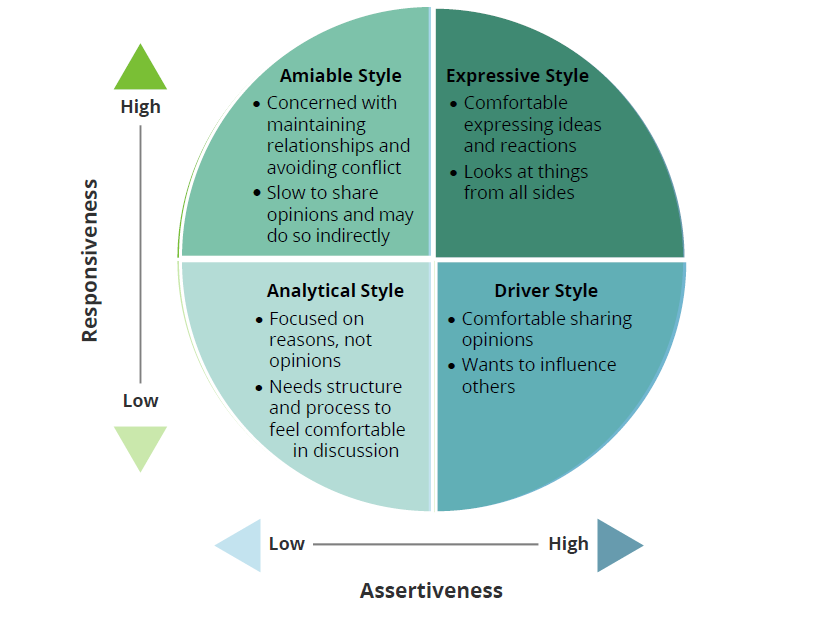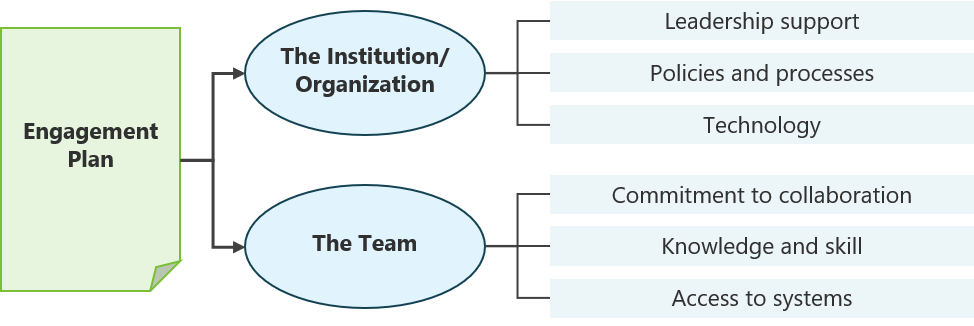Best Practice 1: Communication Style Flexing.
Communication style flexing is adapting your communication style for the individual you are communicating with. Style flexing requires self-awareness and skill. Once you know your own communication style, you can adjust it based on who you are communicating with so that your message is received successfully.
Communication style involves two traits: responsiveness and assertiveness. These communication styles occur along a continuum.
- Responsiveness is how much attention we pay to what others are thinking or feeling. The more responsive someone is, the more communication is focused on creating positive relationships with others. Responsiveness prioritizes getting along more than being right.
- Assertiveness is how much we pay attention to getting our thoughts and meaning across to others. The more assertive someone is, the more their communication is focused on influencing others. Assertive communicators prioritize their message being heard correctly over being perceived a certain way.
When a person’s degree of responsiveness and assertiveness are combined, one of four general communication styles can be identified (see the figure below).
Communication Styles

No one communication style is better than another. You can flex your style by being more responsive or assertive in response to the style of the person with whom you are communicating.
Best Practice 2: Active Listening.
Active listening is an effort to fully concentrate on, understand, and respond to information others share with you.
Active listening involves:
- Removing hurdles that prevent sharing information.
- Get rid of distractions such as phones or email.
- Make eye contact with the speaker, if you are in person.
Showing you are listening:
- In person or via Skype or similar software:
- Maintain eye contact.
- Use non-verbal cues such as nodding or smiling to show that you understand and to encourage the speaker to continue.
- On the phone:
- Use verbal cues such as saying “mm-hmm” or “I see” to show that you understand and to encourage the speaker to continue.
Asking for clarification if you do not understand:
- Confirm the meaning of words or phrases the speaker uses.
- If you do not understand, ask for help.
Confirming your understanding:
- Restate what the speaker has told you in your own words and ask if you got it right.
Best Practice 3: Adapting to Differing Perspectives.
A practice related to one's background could be as simple as shaking hands.
Like communication style, individual communication is shaped by our background.
Our backgrounds provide us with a shared understanding of the world among a group of people, which creates shared meaning, language, and practices. These can be based on many things, including generation, , occupation, or geographic location. One’s background influences the rules they follow when they communicate. For example, some groups rely heavily on context—unspoken rules or general understanding—when communicating. As a result, they will be less direct when sending a message, expecting the listener to be able to use context to interpret the message correctly. A researcher might use scientific terms or shorthand with peers, but these might not have meaning for people in the community.
One’s background can influence a wide variety of communication behaviors, such as:
- Whether messages are given directly or indirectly.
- The amount of space between people or use of touch when communicating.
- The amount of personal information shared in conversations.
- The volume of speech or nonverbal expressiveness used.
- The amount of formality or informality in messages and responses.
- The use of eye contact when giving or receiving messages.
Teams that include a wide range of backgrounds can communicate more effectively by:
- Asking each team member about how they interpreted a specific message.
- Identifying the influences on each member of the team and brainstorming ways that team members can accommodate one another.
- Planning communication with the team members in mind so that everyone can understand.
- Encouraging team members to consider influences when interpreting messages and seeking clarification rather than making assumptions.

